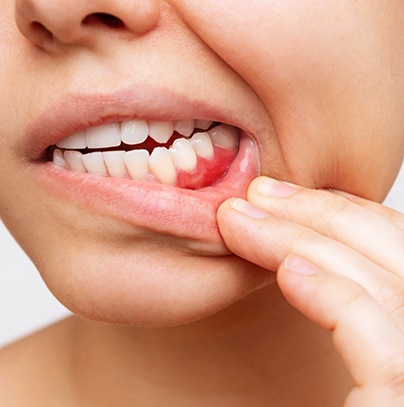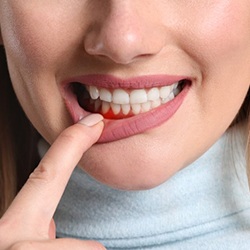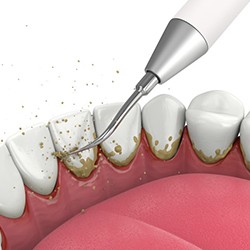Gum Disease Treatment – Garland, TX
Relief from Sensitive or Bleeding Gums
After brushing your teeth, do you sometimes spot a bit of pink in the sink? Bleeding gums might not seem like a huge deal, but this often indicates a common infection called gum disease. While gum disease (also known as periodontal disease) starts with relatively minor symptoms, it can progress to the point where your gums recede and your teeth loosen (or even fall out!). At North Garland Family Dental, we can tackle gum disease early on and save your smile using minimally invasive periodontal therapy. To learn more or to book an appointment, call our Garland dental office today.

Why Choose North Garland Family Dental for Gum Disease Treatment?
- Experienced, Friendly Dental Team Who Treats You Like Family
- Appointments As Early As 7 AM
- Advanced Dental Technology Keeps You Comfortable
What is Gum Disease?

Since gum disease is something roughly 50% of adults in America struggle with, there’s a good chance you’ve heard of it. But what is it exactly? In short, it’s an infection that wreaks havoc on your oral health. As we mentioned above, the symptoms seem pretty insignificant at first, like slight bleeding when you floss, but, if left untreated, it can lead to serious consequences, including loose teeth. So, if you are experiencing any abnormal dental symptoms, don’t hesitate to get in touch with us to schedule an appointment.
Symptoms of Gum Disease

We mentioned that bleeding gums is a common warning sign of gum disease. We also recommend keeping your eye out for the following symptoms:
- Persistent dental sensitivity
- Swollen, red, or inflamed gums
- Chronic bad breath
- Pain when chewing
If any of these arise, call our family dentist ASAP to schedule an exam. The sooner you do, the sooner they can determine if gum disease is the culprit and, if it is, the best way to eliminate the infection.
How Do We Treat Gum Disease?

The treatment we recommend will depend largely on one thing: the severity of the infection. That’s why the initial exam is so important! Once we’ve learned about your symptoms and examined your gums, we can review your treatment options and share which one we recommend.
Scaling & Root Planing

More often than not, periodontal disease develops because bacteria-filled plaque and tartar have accumulated on the teeth beneath the gum line, inflaming and irritating the surrounding tissues. Our dentists can target these areas with a non-surgical procedure called scaling and root planing. Scaling involves using small instruments to remove plaque and tartar, while root planing smooths out the rough surfaces of the tooth roots. This reduces the risk of reinfection in the future by making it more difficult for plaque to build up near the gums.
Do I Need Scaling & Root Planing?

While periodontal disease is still in the early stages, you may be able to take certain measures to help reverse your situation. In some cases, patients might adjust their at-home brushing and flossing regimen to effectively restore their gums to health. But if the problem continues or worsens over time, scaling and root planing may become the extra step needed to protect your smile.
Here are some of the common indications that you will want to visit your dentist for this procedure:
- Visible plaque has accumulated around your teeth and gum line
- Your gums begin to bleed while brushing your teeth
- Noticeable gum recession
- Inflammation and redness in the gums
- Chronic bad breath (halitosis)
The Process of Scaling & Root Planing

In the majority of cases, scaling and root planing will consist of two separate appointments to provide the deep cleaning necessary to reverse periodontal disease. Firstly, our team will begin with the scaling process which involves removing plaque and tartar from along your gum line and below it. This is so that we can confirm that there are no bacteria around your teeth or beneath your gums. You’ll then be sent home so that your mouth can heal properly before the next phase.
Root planing will occur during your second appointment, which is when we will use special dental instruments to smooth the surfaces of your tooth roots. This process does two things: it allows your gums to heal and attach to the roots more effectively, and it also makes it much more difficult for bacteria to accumulate and cling to the roots in the long run.
Aftercare Tips for Scaling & Root Planing

Scaling and root planing can sometimes take around a couple of weeks to complete, as your gums will need sufficient time to recover between sessions. After each appointment, you’ll want to consider implementing a few measures to reduce discomfort and sensitivity, such as:
- Gently brush and floss your teeth
- Rinse your mouth with warm saltwater
- Eat softer foods for at least the first 48 hours following your visit
- Avoid acidic, spicy, cold, and hot foods
Antibiotic Treatment

As gum disease progresses, tiny pockets of bacteria can develop along the gumline. Instead of cleaning them manually with dental instruments, we can take a gentler approach with the use of a topical antibiotic. We can apply medicines, such as tetracycline and doxycycline, directly to the diseased tissues. It dries quickly and then spreads throughout the gums over the next few days, eliminating bacteria in even the deepest pockets.






